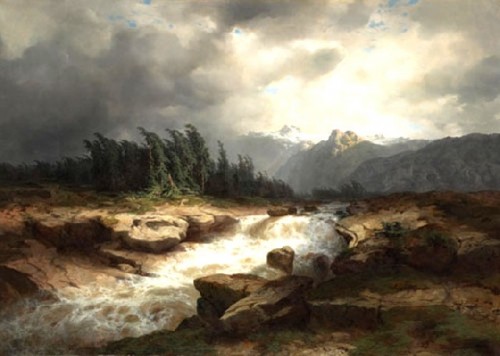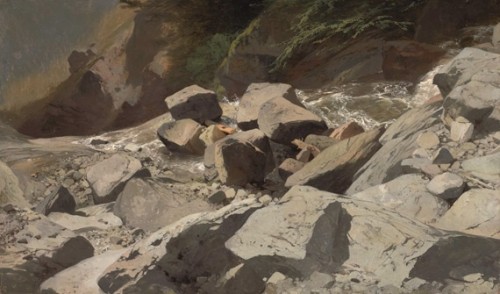Swiss Art at The Clark Art Institute
"Alpine Views: Alexandre Calame and the Swiss Landscape"
By: Gregory Scheckler - Oct 23, 2006
The Swiss Alps jut out above
The last time I was in the
Many of Calame's (1810 – 1864) paintings parallel the earliest phases of American landscape painting formed by the
And what is the hot theme of landscape painting in the 18th and 19th centuries? Nature revealed the divine. Today. this god-and-country idealism can seem to be a ho-hum conservative dream. But in the 19th century it was all the rage, so much so, that when Darwin's theories proposed to replace divine actions with dual forces of natural selection and randomness, most people scoffed. When a variety of 19th century mapmakers considered their early ideas of plate tectonics and contintental drift– founding a new geological science directly related to the formation of mountains such as the
Yet Calame's paintings also show a variety of departures away from earlier Academy painting methods. You might choose to pay special attention to Calame's brushwork, radical scrapings, and textures; how they careen thickly rather than always smoothly. For a contrast with Academic smoothness, you might compare Calame's brushwork with paintings by Louis-Leopold Boilly, (1761-1845), or Jean-Leon Gerome (1824-1904), both in the
Calame also had fun with some academic conventions. For example, in Grimsel Road, Calame denies the traditional repoussoir – a framing of the outside edges of the canvas with trees or stones to enhance the sense of depth. He chose instead to plunk down a keystone dark and in the middle of the frame. This is a reversal of Nicolas Poussin's (1594-1665) and Claude of Lorraine, or Claude's (1600-1682), landscape formulas, a turning of it inside-out. It makes the glacial, erratic boulder the centerpiece rather than the sideline, emphasizing one of Calame's favored motifs of smaller rocks and boulders adding up into gargantuan mountains. Apparently, Calame's divine "Author of all beauty and truth" does not follow artist's little rules.
There is a fierce integrity to Calame's paintings, a breadth of color and depth of visual investigation that is all too missing in most contemporary landscape painting, which is more usually a simplistic plein aire study made on a nice sunny day. Calame's Torrent paintings show us impossibilities, memories of events we can know but that can never be painted from life; dark storms careening across mountains, shafts of light held motionless, animated floods, windswept and swooning evergreens. You'll see what I mean if you imagine being an artist, trying to place your easel on a rocky outcropping during one of the Torrent scenes. You'd be swept away in the flood or blown off the mountain in the wind. You'd get frostbite if you stood still too long painting The Mythen. These paintings aren't even just one scene – they are many studies combined and composed to create a new vision. Calame's recombinations do much more than merely mimic the world, they create a subtle fantasy that gives justice to the more extreme qualities of the
It's quite interesting to view paintings by Calame's teacher Francois Diday, as well as of both artist's followers and students. The curatorial and design teams excellently crafted the exhibit so that audiences can find contrasts and connections among the artists. Viewing the subtle variations among their paintings is somewhat like seeing a group of artists all use the same aesthetic form and grammar, as if together they were writing a haiku or a sonnet. Diday occasionally followed well-known formulae for tree painting (see his
The catalog for this exhibition is the first to contain color reproductions of many of the paintings. As a bonus if you buy it you get a free bar of Toblerone chocolate. For a well-designed website see http://www.clarkart.edu/exhibitions/calame/index.cfm
Copyright Gregory Scheckler, C 2006




